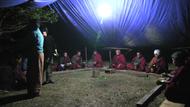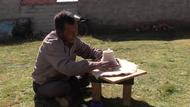Video Overview
This is a discussion about how people with visual impairments, speech impairments, and hearing impairments cope with their disabilities in Tibet.
- Lhasa
- Ü
- བུད་མེད་: མིག་(གིས་)མ་ཐོང་བ་བྱས། ཨམ་ཅོག་མ་གོ་བ་བྱས། ལྐུགས་པ་ཨེ་འདྲས་ཡོད་ན་ག་རེ་བྱས། སློབ་གྲྭ་ཨེ་འདྲས་ཡོག་རེད་པས།Woman: Are there any schools for people who cannot see or speech-impaired?
- སྐྱེས་པ་: ཡོག་རེད། ཡོག་རེད།Man: Yes, there are.
- བུད་མེད་: ལྷ་སར།Woman: In Lhasa?
- སྐྱེས་པ་: དེང་སང་ཡོག་རེད།Man: Nowadays, there are.
- བུད་མེད་: ཨང་་་་་།Woman: I see.
- སྐྱེས་པ་: ལྟ་དེང་སང་ཡོག་རེད། སྔས་མ་ཡིན་ན་གང་ཟེར་དགོས་ཀྱི་རེད། ལྐུགས་པ་ཡིན་ན་ལྐུགས་པ་རང་རེད།Man: Nowadays, we do have particular schools for persons with disabilities. Before we did not have any schools for them, and [those who are] mute remained mute.
- སྐྱེས་པ་: ལྐུགས་སྐད་རྒྱག་དགོས་ཀྱི་རེད་པ།Man: They used the 'mute-language.'
- བུད་མེད་: འོང་ལགས།Woman: Right.
- སྐྱེས་པ་: ལྐུགས་སྐད་ཟེར་ནའི་ལྟ་ལག་པས་ཁ་ལག་བཟའ་དགོས་ཀྱི་ཡོད་ན། ལག་པས་ཁ་ལག་བཟོ་ཟེར།Man: That 'mute-language' was nothing more than a limited few hand gestures. If a mute person needed to eat, we would tell that person with the hand gesture.
- སྐྱེས་པ་: ཨེ་འདྲ་སེ་ལབ་དགོས་ཀྱི་རེད་པ།Man: That is how it was done then.
- བུད་མེད་: ལགས་སེ།Woman: Right.
- སྐྱེས་པ་: ལྟ་གཅིག་གཞན་དག་ག་རེ་ཡིན་ནའི་གང་ག་ལོགས་ལག་པས་ལག་བརྡ་བྱས་བྱས་མ་གཏོགས་ཧ་གོ་གི་མི་འདུག་གMan: So everything was communicated through hand gestures alone.
- བུད་མེད་: བྱས་ཙང་། ཨཱ་ནི་མི་ལོང་བ་ཡིན་ན་ལག་བརྡ་མཐོང་གི་མ་རེད་པཱ། གང་འདྲ་བྱེད་དགོས་ཀྱི་རེད།Woman: Indeed. What if someone is blind? That person can't see the other's hand gesture. What would the blind people do then?
- སྐྱེས་པ་: ལོང་བ་ཡིན་པ་ཡིན་ནའང་ཨམ་ཅོག་གོ་གི་རེད་པཱ།Man: If someone is blind, he or she can still hear other people.
- བུད་མེད་: འོང་།Woman: Right.
- སྐྱེས་པ་: སྐད་ཆ་བཤད་པ་དང་།Man: They can also speak.
- སྐྱེས་པ་: ལྟ་དེང་སང་ལྐུགས་པའི་སློབ་གྲྭ་ཡོག་རེད།Man: These days, there is a school for mute people.
- བུད་མེད་: འོང་ཟེར།Woman: I also heard that.
- སྐྱེས་པ་: ལྐུགས་པའི་སློབ་གྲྭ་ཡོག་རེད་ཟེར་གྱི་འདུགMan: There is an individual school for those who are mute.
- སྐྱེས་པ་: ལྐུགས་པའི་སློབ་གྲྭ་འདའི་ལྟ་བཙུགས་ནས་ད་ལྟ་རྒྱུན་རིང་པོ་འགྲོ་གི་ཡོག་མ་རེད།Man: And that school is recently built for the speech-impaired students.
- བུད་མེད་: འོང་འོང་། ངས་གཅིག་མཐོང་བྱུང་རྒན་ལགས། འདི་རེས་པས་ལོང་བ་ཡིན་ན་ཨེ་འདྲས་སེ་ལག་པས་ཨེ་འདྲས་ཨེ་འདྲས་ར་ཅིག་བྱས་བྱས་བྱེད་མཁན་རེད་པས།Woman: Right, right. I saw one before. Is it one where the students are trying to feel with their fingers? Like I am doing it right now.
- སྐྱེས་པ་: འོ། ལག་པས་གང་ལྟར་ཡི་གེ་འཚོལ་ཡག་འདུག་ག ཡི་གེMan: Right, they are reading the letters with their fingers.
- བུད་མེད་: ཨཱ་ལས། མིག་མེད་ན།Woman: I see, that is how they do it.
- སྐྱེས་པ་: འོ། ཁོ་ཡི་གེ་འཚོལ་ཡག་འདུག་གMan: Correct, they can feel for words.
- བུད་མེད་: ཨཱེ་འདྲ་ར་ཅིག་བྱེད་ཀྱི་འདུགWoman: They are gesturing like this.
- སྐྱེས་པ་: ལྟ་ཁོ་ཡི་གེ་འཚོལ་ཡག་བྱས། ཁོ་མིག་མ་མཐོང་བ་ནའི།Man: So the visually-impaired can read.
- བུད་མེད་: མིག་མ་མཐོང་ནའི་འོ་ཨེ་འདྲས་བྱེད་ཀྱི་འདུག་མིན་ཨེ་འདྲས་ར་ཅིགWoman: Even if they cannot see, they can feel things like I am doing it now.
- སྐྱེས་པ་: ཁོ་ལག་པས་ཡི་གེ་བཙལ་བྱས་ཁོས་དེའི་དོན་དག་དེ་གང་ག་ལོགས་ཁོས་ཧ་གོ་གི་ཡོག་རེད་དཱ།So a blind person can read the words and understand their meaning.
- བུད་མེད་: ཨཱ་ནི་འོན་ཀོག་ཡིན་ན་རྙོག་ཁྲ་ཡོག་རེད་དཱ། འོན་ཀོག་ཡིན་ན་གང་འདྲ་བྱེད་དགོས་ཀྱི་རེད།Woman: If you are deaf, then it must be harder. What can a deaf person do?
- སྐྱེས་པ་: འོན་པ་ཨས།Man: Did you mean if someone is deaf?
- བུད་མེད་: འོ།Woman: Yes.
- སྐྱེས་པ་: ལྟ་འོན་པ་ཡང་དེང་སང་ཡང་འོན་པ་ཨམ་ཅོག་་་་་།Man: Nowadays, the deaf can still use......
- བུད་མེད་: ཨཱ་ལས། འོང་རེད་ཨམ་ཅོག་ནང་ལ་འདུག་སེ་གཅིག་བླུགས་ཡག་འདུག་སེ། སྐུད་པའི་བཟོ་ལྟ།Woman: I got what you mean. They can put the hearing aid in their ears, the one that looks like a thread.
- སྐྱེས་པ་: ཨམ་ཅོག་ཉན་ཡག་དེ་ཡོག་རེད་ཁོ།Man: They can use a hearing aid.
- བུད་མེད་: འོ་འོ།Woman: I see.
- སྐྱེས་པ་: འོ་་་། ཁ་པར་དེ་ཡོག་རེད།Man: Right, they have hearing aids.
- བུད་མེད་: འོ་ལྟ་མིན་ཡག་པོ་རེད།Woman: Right, that is good.
- སྐྱེས་པ་: ཉན་པར་དེ་འདིའི་ནང་དུ་བླུགས།Man: You can put the hearing aid here.
- བུད་མེད་: འོ་འོ།Woman: I see.
- སྐྱེས་པ་: ཨཱ་ནི་ཁ་གང་ཟེར་ནའི་སྐད་ཆ་འདི་གས་ཡང་གོ་གི་ཡོག་རེད་ཁོས།Man: With the help of that gadget, they can hear a conversation.
- བུད་མེད་: རེད་པས། བྱས་ཙང་།Woman: Right, that is correct.
- སྐྱེས་པ་: ལྟ་ལྐུགས་པ་ཁག་ཅིག་སྐད་ཆ་བཤད་མ་ཐུབ་པ་ཡིན་ན།Man: In case of the mute who cannot express themselves,
- བུད་མེད་: འོ་རེད། ཁ་ནས་མར་བཤད་མ་ཐུབ་ལག་པས་ཨེ་འདྲས་བྱེད་ཀྱི་འདུགWoman: Right. Even they cannot speak, they use hand-gestures like this.
- སྐྱེས་པ་: ལག་པས་བྱེད་ཀྱི་འདུག་གཱMan: That is right, they use sign-language.
- སྐྱེས་པ་: གསར་འགྱུར་ལྟ་དུས་གཅིག་གིས་དེ་ནས་སྐད་ཆ་བཤད། ཨཱ་ནི་ད་ལྟ་གསར་འགྲྱུར་ག་རེ་ག་རེ་བཤད་ཀྱི་ཡོད་མེད། ཨཱ་ནི་འདུག་སེ་འདུག་ལབ་བྱས། ཨཱ་ནི་འདུག་སེ་བྱས་བྱས།Man: During a news broadcast, one news presenter tells the news, and another person uses sign-language and translates. Like this.
- བུད་མེད་: ཨེ་འདྲས་ཨེ་འདྲས་ར་ཅིག་བྱས་བྱས།Woman: Gesturing like this.
- སྐྱེས་པ་: འོ་འདུག་སེ་བྱས་བྱས། འདུག་སེ་བྱས་བྱས་དགའ་པོ་ཞེ་དྲགས་འདུག་ཟེར་དུས་ལག་པས་གང་རེད། ཨེ་འདྲས་ར་ཅིག་བྱེད་ཀྱི་འདུགMan: That is correct, and that is how they do it. When they want to express a feeling of happiness, they curl their fingers like this.
- བུད་མེད་: སྙིང་ར་དེ་ཨེ་འདྲ་ར་ཅིག་བྱེད་ཀྱི་འདུག་ག ཚུར་འཆམ་པོ་ར་ཅིག་ཡོད་པའི་བཟོ་ལྟ།Woman: For heart symbol, they curl their index fingers with two thumbs pointing down. For expressing closeness, they cross their two arms.
- སྐྱེས་པ་: འོ་འདུག་སེ་བྱས་འདི་ཁོའི་སྐད་ཆ་རེད།Man: That is their language.
- སྐྱེས་པ་: ལྟ་ལྐུགས་པ་ཚོས་འདི་སྐད་ཆ་བཤད་མ་ཐུབ་མཁན་གྱིས་བལྟས་པ་ཡིན་ན་འདི་ཕ་གིའི་དེ་གས་གང་གMan: Speech-impaired people can communicate through sign-language.
- སྐྱེས་པ་: འདི་བསླབ་ཡག་ཡོག་རེད་ཟེར། བསླབ་གྲྭ་འདི་པར་འདུག་སེ་ཡོག་རེད།Man: There are individual schools that teach sign-language.
 Loading ...
Loading ... 


































































































